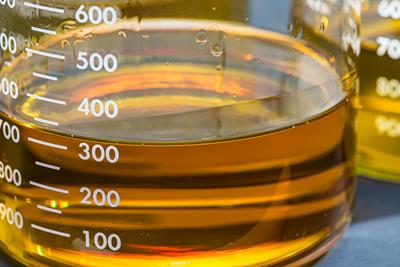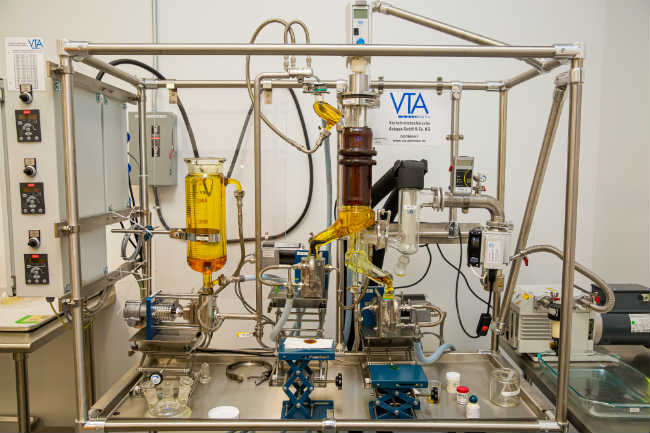
Sunday November 28, 2021
By Erin Hiatt
 Education
Education
What do cannabis gummies, chocolate, mints, beverages, and topicals have in common? Many of them are made with cannabis distillate oil, an extract that is odorless and flavorless, making it the perfect solution for those who wish to make potent cannabis-infused foods and topicals free from that grassy and/or skunky taste and aroma.
Making edibles with distillate is easy, but there are a few important things to be aware of before you dive in.
What is Cannabis distillate?
To make cannabis distillate, manufacturers utilize a process called short path distillation, which uses steam, heat, vacuum pressure, and certain boiling points (depending on the cannabinoid) to isolate and purify the desired cannabinoid.
This distillation process isolates cannabinoids and terpenes from one another, so THC, CBD, and plant matter and terpenes, once extracted, are in their purest and most potent form - in some cases as high as 99 percent THC.
What’s left is an odorless, flavorless oil ideal for making distilled edibles. Distillates also make it much easier to precisely dose your recipes, which can be trickier when trying to make edibles with cannabis infused oil or butter.

Many consumers enjoy cannabis distillate because it is versatile; it can be used sublingually, vaped, in beverages, a drop or two can be added to joints, dab rigs, or bongs, and as we’ve mentioned, distillate is a terrific way to make edibles, from savory to sweet.
Consuming cannabis in distillate form has some pluses and minuses. On the plus side, they are fully decarboxylated (a necessary process to unlock a cannabinoid’s attributes, such as euphoria or pain reduction), and they’re pure and potent. However, for some, potency may be a quality to add to the negative column. Because they are pure cannabinoid, a THC distillate will get you mighty stoned and right quick. Additionally, distillates do not work in harmony with other cannabinoids or terpenes, so consumers receive none of the benefits of the entourage effect, which posits that the components of cannabis work better together than in isolation. For one last distillate drawback, to buy one of high-quality you should expect to pay a pretty penny.
Once you’ve found a quality CBD or THC distillate, you can take it to the next level and start making your own distillate edibles at home.
Making Homemade Cannabis Edibles with Distillate
Cooking or baking at home with cannabis distillates is actually very simple, though maybe not quite as simple as putting a few drops from a dropper into a pre-made brownie mix. At the very least, you’ll have to do some stirring.
Lucky for us, our very own PotGuide contributor Abby Hutmacher has spelled out a foolproof method to make DIY cannabis distillate infused edibles:
What You'll Need:
- One gram cannabis distillate
- A bowl of hot water
- Oil or butter
- An oil or butter-based recipe
Instructions:
- With the distillate in its container, place in a bowl of hot water to warm the concentrate. Remember, cannabinoids like THC begin to degrade at 230 degrees Fahrenheit so make sure the temperature is lower than that
- While the distillate warms, measure out the oil or liquefied butter to the recipe’s specifications
- Drop the gram of distillate into the oil or butter and mix thoroughly to ensure homogenization, a process that breaks big particles into small ones and provides a uniformity to the product
- Place the combined distillate/oil or butter mixture into a microwave-safe dish and heat on medium power for up to two minutes to ensure all ingredients are combined
- Your oil is ready to be infused into your recipe
As mentioned above, cannabinoids exposed to high temperature degrades, so if you’re baking, be sure to keep the temperature at 325 degrees Fahrenheit or lower. Rest assured, you won’t lose much of cannabis’ kick through baking. Remember, distillate is extremely potent!
How to Make Cannabis Infused Gummies with Distillate
Making homemade distillate-infused gummies is a crowd-pleaser and easy to do, though dosing can be a bit tricky with these tiny treats (more on that in a minute). Check out the simple recipe below:
Ingredients:
- 1 cup fruit puree or fruit juice
- ¼ cup water
- 1 ½ tablespoons of gelatin, or for vegan folks, agar is a fine substitute
- 4 tablespoons granulated sugar
- ⅛ teaspoon pink salt
- 1 gram cannabis distillate (pro tip: grab your calculator and divide the total milligrams of the distillate by the number of gummies you plan to make to figure out the approximate dosage per gummy)
Instructions:
- Heat the fruit puree or juice in a medium saucepan over medium heat
- With puree heating, pour gelatin and water in a bowl and mix until well-dissolved
- When puree reaches a low boil, add granulated sugar and pink salt, then mix until dissolved
- Slowly add the water and gelatin mixture to the puree, stirring constantly, for about three minutes
- Add the cannabis distillate and stir until thoroughly combined to ensure homogenization (if you have a candy thermometer handy, ensure that the fruit puree is below 350 degrees Fahrenheit)

- Pour or scrape your gummy mix into a turkey baster syringe for transfer into the gummy molds. Handle with care, it will be hot!
- Fill the molds and let it sit at room temperature for 20 minutes
- After 20 minutes have passed, place molds in the refrigerator for at least 15 minutes or until the gummies set
- After the gummies set, remove them from the mold and toss them with granulated sugar to keep them from sticking
Voila! Your homemade gummies are ready to eat!
Conclusion
Now that you’ve got a couple of recipes handy, it’s time to find a great distillate for your at-home cannabis culinary adventures. Head first to your local dispensary where you know that the distillate has been tested for quality, cannabinoid potency, and purity. Remember, a high quality distillate should be a golden, viscous oil with excellent clarity. If the distillate looks or smells funny - do not use it!
Frequently Asked Questions
What is distillate?
A cannabis distillate is an ultra-refined, single cannabinoid extract frequently found in edibles, topicals, and vape cartridges.
How are distillate edibles different from other edibles?
The primary difference between distillate edibles and others is that distillates deal with one cannabinoid at a time. Edibles made from full-spectrum cannabis contain more than one cannabinoid as well as plant terpenes giving them that distinctively earthy taste and scent.
Do distillate edibles get you higher?
If the edible is made from THC distillate, it very well could. However, there are a lot of factors contributing to your personal high, including frequency of consumption, body weight, gender, etc. Due to the lack of terpenes, some describe it as a “narrower” high, and may last shorter than an average high.
Do distillate edibles work faster?
The standard time for edibles to take effect is around 30-60 minutes. However, an edible with THC distillate may kick in faster. Follow the cannabis golden rule here: start low and go slow. Wait at least 60 minutes before consuming more to avoid the dreaded green out.







